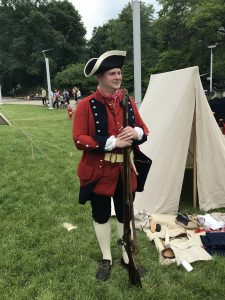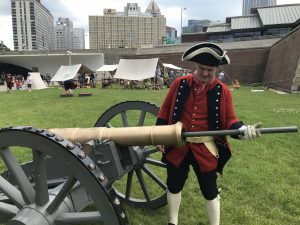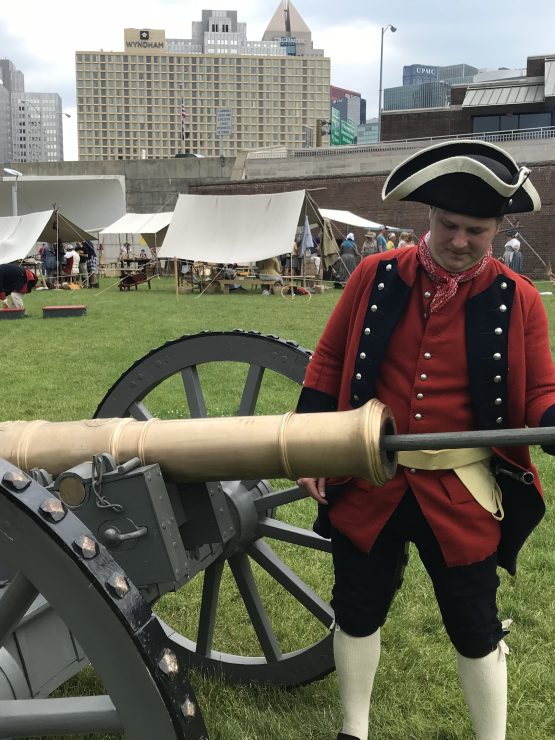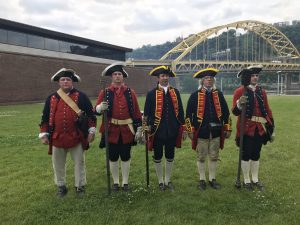 From muskets and blacksmithing to cooking and laundry demonstrations, 18th century life at Fort Pitt roars to life on select summer weekends in Point State Park.
From muskets and blacksmithing to cooking and laundry demonstrations, 18th century life at Fort Pitt roars to life on select summer weekends in Point State Park.
Re-enactors (also called “interpreters” or “living historians”) in the Fort Pitt Museum’s living history programs give visitors a glimpse into daily life at the Point 200+ years ago.
We talked to re-enactor Floyd Dierker about living history and how it helps visitors see history in a whole new way.
Fort Pitt Museum: What does it mean to be a re-enactor?
Floyd Dierker: A re-enactor is someone who attempts to recreate aspects of a specific time period. We focus on both the material culture (clothing, accessories, tools, daily essentials, etc.) as well as the mindset and language of the period.
FPM: How did you get started as a re-enactor?
FD: As a child, I always appreciated seeing living history demonstrations but never knew how or where to get involved. I found out that a friend of mine was going down to the Fort Pitt Museum to help with cannon firings. I asked if I could tag along one time, and the rest is history.
FPM: What do you enjoy most about it?
FD: I love when I see history coming alive in someone else’s eyes. In school, history is often a study in memorization and regurgitation, which at times makes it difficult to fully immerse yourself in and understand. When I can see a concept sink in to someone, there’s a feeling of accomplishment, and I see that I may have sparked the same interest in history that was sparked in me years ago.
 FPM: What’s your favorite era in history to re-enact?
FPM: What’s your favorite era in history to re-enact?
FD: I am only focused on re-enacting the 18th century. There is so much going on socially, economically, and culturally that just make it such a great time in our history. You are able to see concepts that help shape 13 colonies into a new country. It also helps that a lot of that history took place in our backyards.
FPM: How do you prepare to bring 18th century Fort Pitt to life during a living history program?
FD: There is so much that goes into taking Fort Pitt back into the 18th century. Before I ever show up, cannon rounds or musket rounds have been prepared and the safety lines have been put up outside. I always try to pick up food that would have been commonly eaten during the time period (fresh berries, cherries, small apples). I usually show up to the fort with my clothing in a separate container and change there. (People give you funny looks when you are wearing 18th century clothes driving down Route 28!) After I have changed, I usually go about helping set things up like the cannon or the forge. All in all, I would say that if we have a program starting at noon, we have been setting up since 9 a.m.
FPM: Why do you think living history programs are valuable for educating the public?
FD: History is extremely important, and through studying it, we can see how our ancestors overcame adversity to provide us with the comfortable lives that we live today. It is a disservice to our ancestors’ memory to not care. Living history gives insight to both myself and to those who come out to see us. There is no greater feeling than seeing a child be inspired by what they have seen at an event. The moment you see that what is in your textbook is tangible, and you can feel, hear, and even smell what it would have been like, it can’t help but come alive.
Experience 18th century Fort Pitt for yourself during the museum’s upcoming living history demonstrations this summer:
Stay tuned for more Q&As with Fort Pitt Museum re-enactors!
Kim Roberts is the communications coordinator at the Heinz History Center.


